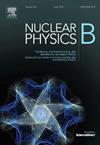Dymnikova-Schwinger GUP-corrected wormholes in f(R,Lm,T) gravity
IF 2.8
3区 物理与天体物理
Q2 PHYSICS, PARTICLES & FIELDS
引用次数: 0
Abstract
In this paper, we present intriguing traversable and asymptotically flat wormhole solutions within gravity. We integrate our model with the gravitational analog of the Schwinger effect, describing the emergence of particle-antiparticle pairs from the vacuum. By introducing a fundamental minimal length via the generalized uncertainty principle, we establish critical constraints on matter distribution and spacetime structure. Our findings reveal how this fundamental length shapes the wormhole geometry, steepening the slope toward the throat and mitigating violations of the weak and null energy conditions. This adjustment allows the supporting matter to avoid phantom behavior at the Planck scale, suggesting a more stable configuration. We also explore the intriguing effects of gravitational lensing, showing that these exotic wormholes repel light rather than capture it. For values ranging from 0 to 45, the deflection angle remains negative for all corresponding values, indicating a repulsive gravitational force that pushes photons away from the throat. Moreover, the forces acting on the wormhole exhibit a delicate balance, demonstrating equal strength in opposing directions–an essential feature of stability. The complexity factor decreases with distance from the throat, indicating that corrections from the generalized uncertainty principle are most significant near the throat and diminish outward. Overall, our work highlights the allure of these wormhole geometries and the pivotal role of quantum effects in their formation, paving new avenues for understanding gravity and spacetime.
f(R,Lm,T)重力下Dymnikova-Schwinger修正的虫洞
在本文中,我们给出了f(R,Lm,T)重力下的可穿越且渐近平坦的虫洞解。我们将我们的模型与施温格效应的引力模拟相结合,描述了真空中粒子-反粒子对的出现。通过广义测不准原理引入基本最小长度,建立了物质分布和时空结构的临界约束。我们的发现揭示了这个基本长度是如何塑造虫洞几何形状的,它使通向喉部的斜率变陡,并减轻了弱能和零能条件的违反。这种调整允许支撑物质避免在普朗克尺度上的幻像行为,这表明了一个更稳定的结构。我们还探索了引力透镜的有趣效应,表明这些奇异的虫洞排斥光而不是捕捉光。当β值在0到45之间时,对于所有相应的α(rtp)值,偏转角保持为负,表明存在排斥引力将光子从喉部推开。此外,作用在虫洞上的力表现出一种微妙的平衡,在相反的方向上表现出相等的力量——这是稳定性的基本特征。复杂性因子YTF随距离喉部的远近而减小,表明广义不确定原理的修正在喉部附近最显著,向外减弱。总的来说,我们的工作突出了这些虫洞几何形状的吸引力,以及量子效应在它们形成中的关键作用,为理解引力和时空铺平了新的道路。
本文章由计算机程序翻译,如有差异,请以英文原文为准。
求助全文
约1分钟内获得全文
求助全文
来源期刊

Nuclear Physics B
物理-物理:粒子与场物理
CiteScore
5.50
自引率
7.10%
发文量
302
审稿时长
1 months
期刊介绍:
Nuclear Physics B focuses on the domain of high energy physics, quantum field theory, statistical systems, and mathematical physics, and includes four main sections: high energy physics - phenomenology, high energy physics - theory, high energy physics - experiment, and quantum field theory, statistical systems, and mathematical physics. The emphasis is on original research papers (Frontiers Articles or Full Length Articles), but Review Articles are also welcome.
 求助内容:
求助内容: 应助结果提醒方式:
应助结果提醒方式:


